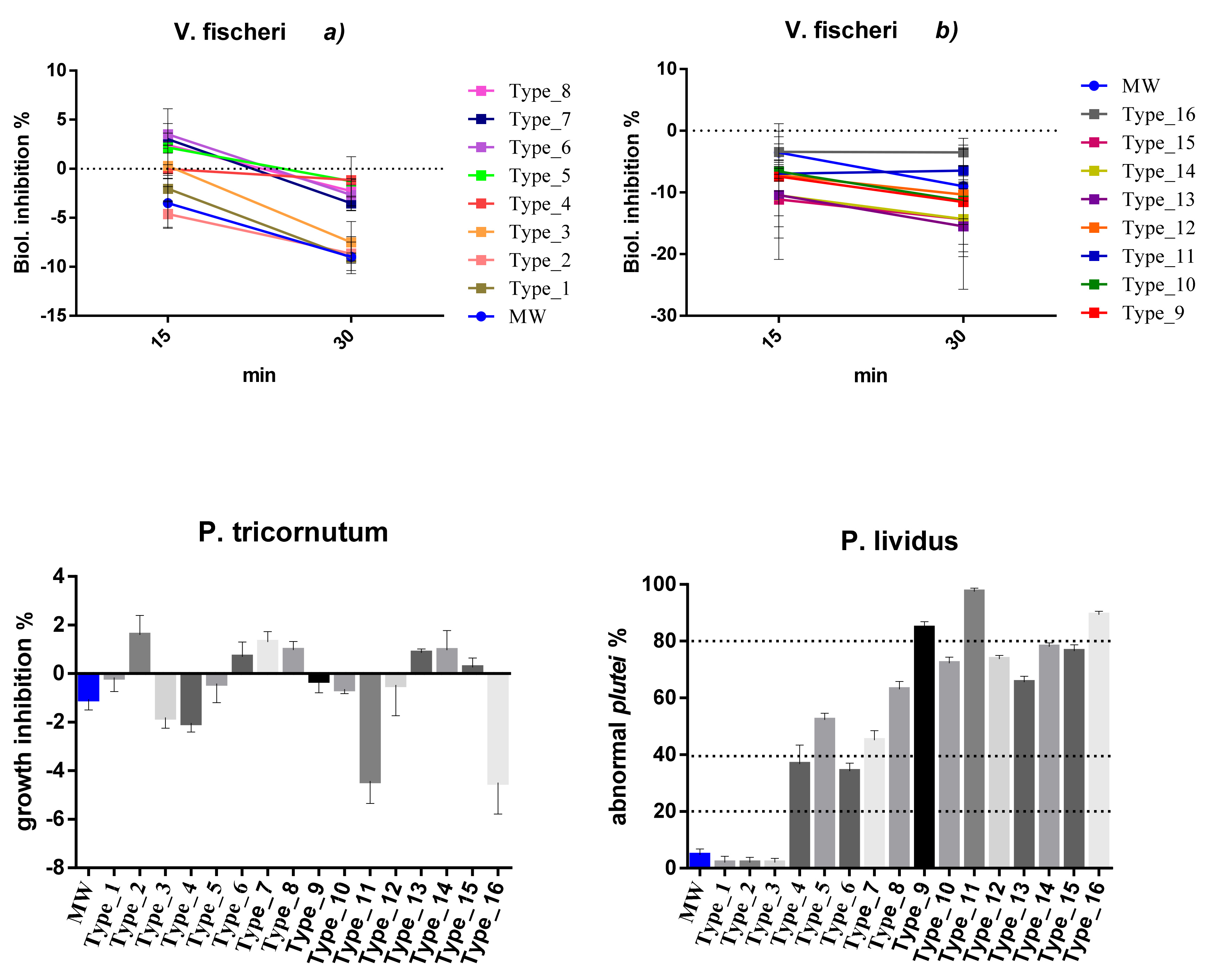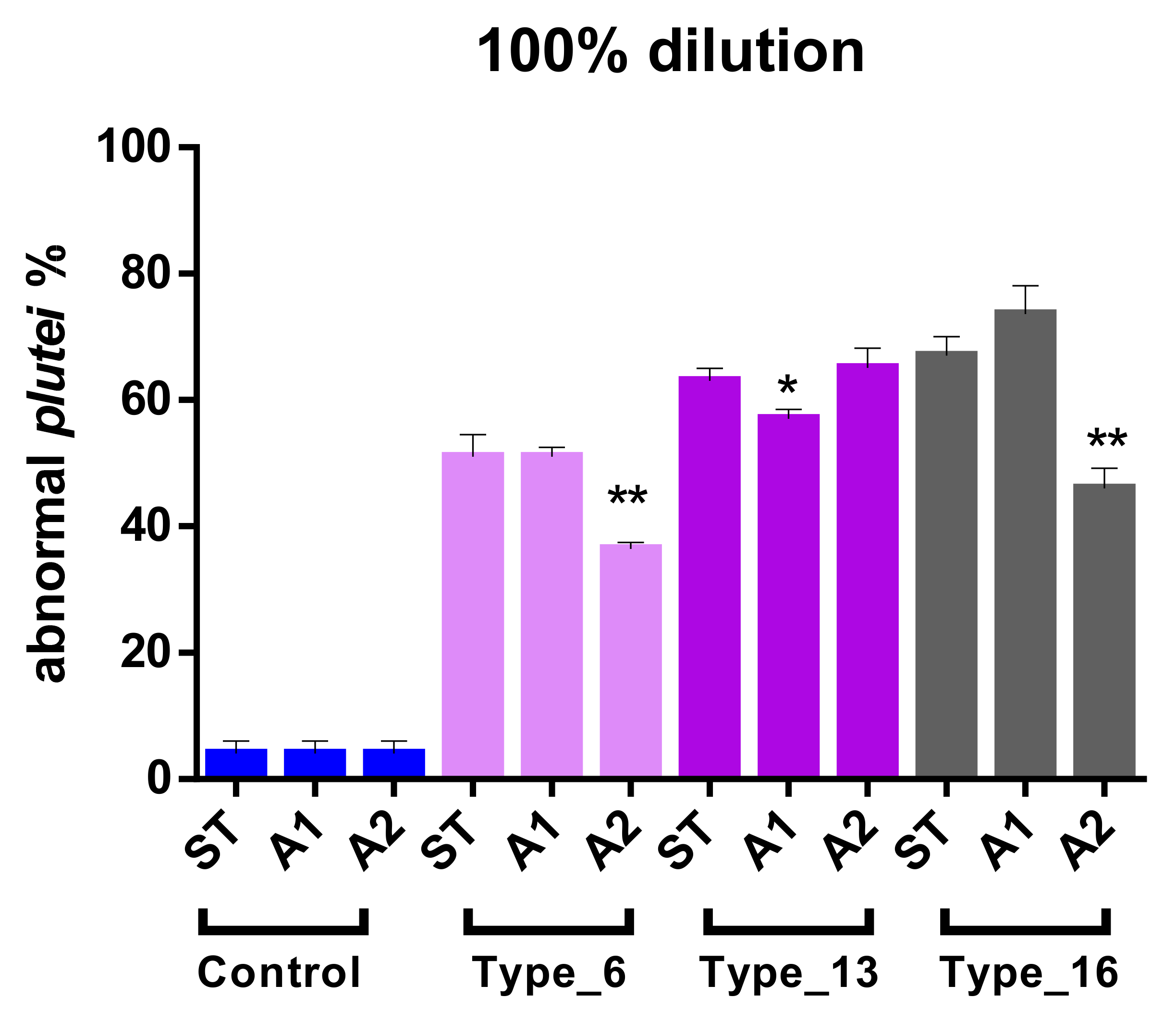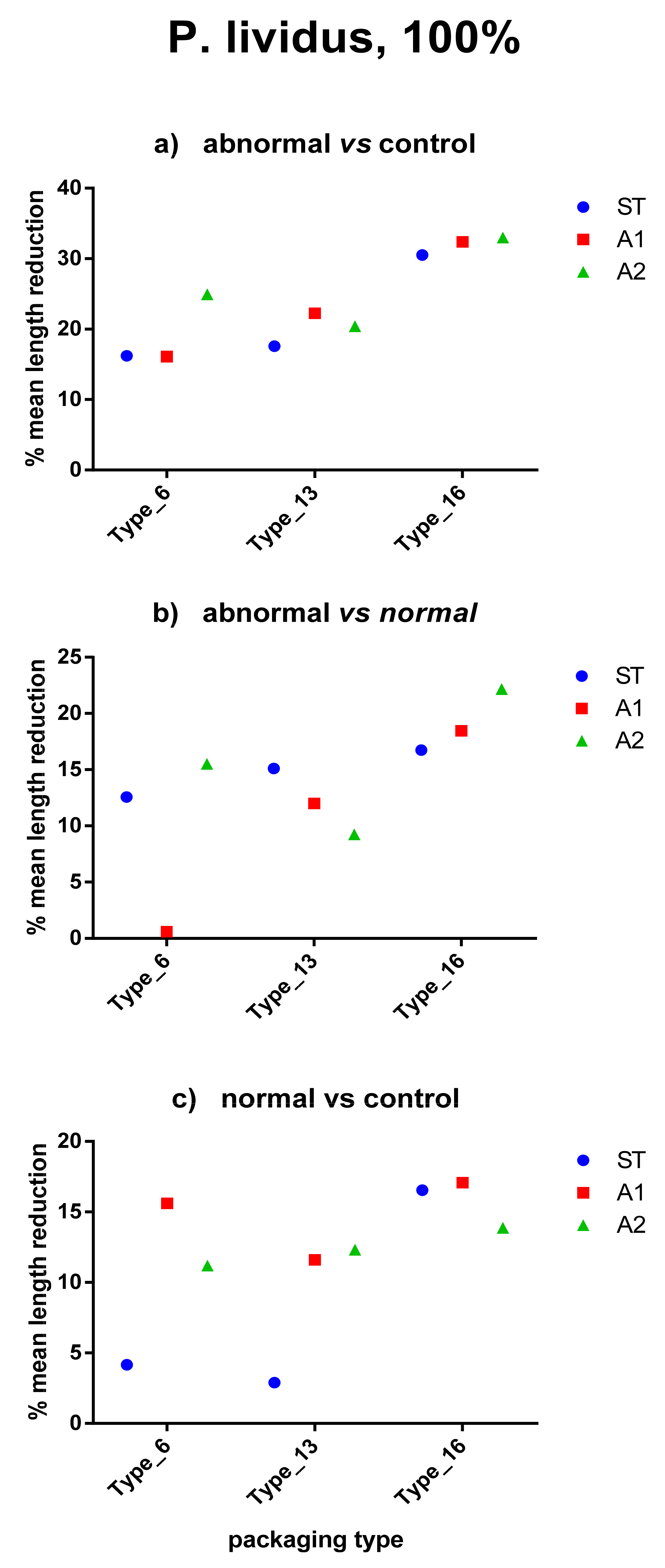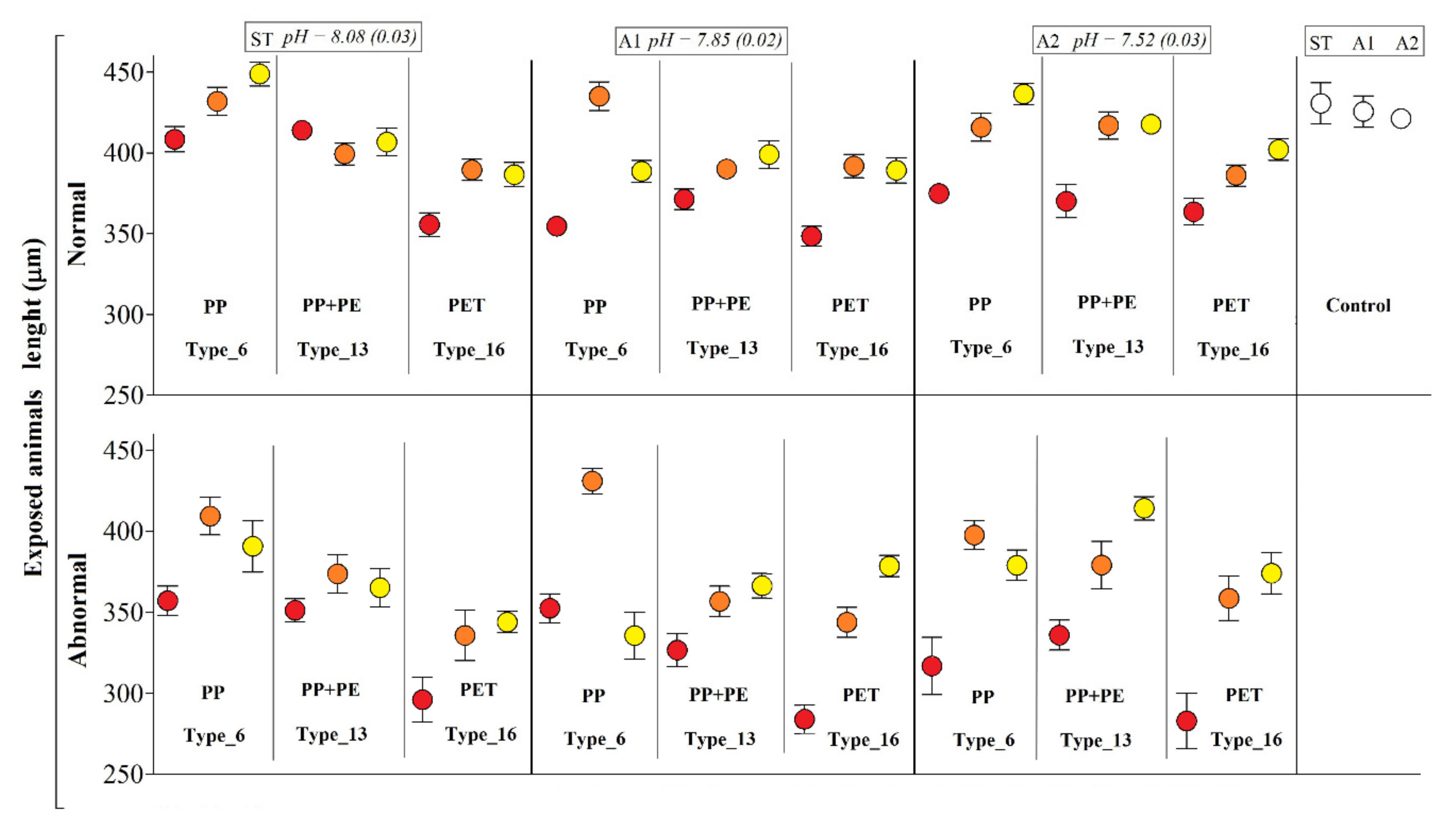Impacts of Plastic-Made Packaging on Marine Key Species: Effects Following Water Acidification and Ecological Implications
Abstract
1. Introduction
2. Material and Methods
2.1. Experimental Design, Packaging Types and Leachates
2.2. μFT-IR Characterization of Plastic-Made Packaging
2.3. Ecotoxicological Tests: Exposure and Endpoints
2.4. pH Effects on Embryo Toxicity and Body-Size of P. lividus
2.5. Quality Assurance and Quality Control
2.6. EC50 Calculation and Statistical Analyses
3. Results
3.1. μFT-IR Characterization of Plastic-Made Packaging
3.2. Ecotoxicological Responses at pH Standard (8.1)
3.3. Water Acidification: Embryo Toxicity and Body-Size Reduction in P. lividus
4. Discussion
5. Conclusions
Supplementary Materials
Author Contributions
Funding
Institutional Review Board Statement
Informed Consent Statement
Data Availability Statement
Conflicts of Interest
References
- Geyer, R.; Jambeck, J.R.; Law, K.L. Production, Use, and Fate of All Plastics Ever Made. Sci. Adv. 2017, 3, e1700782. [Google Scholar] [CrossRef] [PubMed]
- Plastics Europe. Plastics—The Facts; PlasticEurope: Brussels, Belgium, 2020. [Google Scholar]
- Ocean Conservancy. Together, We Are Team Ocean; Ocean Conservancy: Washington, DC, USA, 2020. [Google Scholar]
- Carpentieri, S.; Di Vito, S.; Zampetti, G.; Scocchera, E.; Nuglio, S.; Cugnata, F. Beach Litter, Indagine sui rifiuti nelle spiagge italiane. Legambiente, Maggio. 2018. Available online: https://www.legambiente.it/sites/default/files/docs/dossier_beachlitter2018.pdf (accessed on 28 December 2018).
- Guerranti, C.; Cannas, S.; Scopetani, C.; Fastelli, P.; Cincinelli, A.; Renzi, M. Plastic litter in aquatic environments of Maremma Regional Park (Tyrrhenian Sea, Italy): Contribution by the Ombrone river and levels in marine sediments. Mar. Pollut. Bull. 2017, 117, 366–370. [Google Scholar] [CrossRef] [PubMed]
- AEA. Problemi Prioritari per L’ambiente Mediterraneo; Report AEA 4/2006; AEA: Copenaghen, Denmark, 2006; p. 92. ISSN 1725–9177. [Google Scholar]
- UNEP. Marine Litter Assessment in the Mediterranean; UNEP/MAP 48; UNEP/MAP: Vassileos Konstantinou Ave., Athens, Greece, 2015; p. 45. ISBN 978-92-807-3564-2. Available online: www.unepmap.org (accessed on 15 April 2020).
- UNEP. Marine Plastic Debris and Microplastics—Global Lessons and Research to Inspire Action and Guide Policy Change; United Nations Environment Programme: Nairobi, Kenya, 2016; p. 192. Available online: http://ec.europa.eu/environment/marine/good-environmental-status/descriptor10/pdf/Marine_plastic_debris_and_microplastic_technical_report_advance_copy.pdf (accessed on 28 December 2018).
- Browne, M.A.; Crump, P.; Niven, S.J.; Teuten, E.; Tonkin, A.; Galloway, T.S.; Thompson, R.C. Accumulation of microplastic on shorelines worldwide: Sources and sinks. Env. Sci. Technol. 2011, 45, 9175–9179. [Google Scholar] [CrossRef] [PubMed]
- Eerkes-Medrano, D.; Thompson, R.C.; Aldrige, D.C. Microplastic in freshwater systems: A review of the emerging threats, identification of knowledge gaps and prioritization of research needs. Water Res. 2015, 75, 63–82. [Google Scholar] [CrossRef]
- Mani, T.; Hauk, A.; Walter, U.; Burkhardt-Holm, P. Microplastics profile along the Rhine river. Sci. Rep. 2015, 5, 17988. [Google Scholar] [CrossRef]
- Alomar, C.; Estarellas, F.; Deudero, S. Microplastics in the Mediterranean Sea: Deposition in coastal shallow sediments, spatial variation and preferential grain size. Marine. Environ. Res. 2016, 115, 1–10. [Google Scholar] [CrossRef]
- Blašković, A.; Fastelli, P.; Čižmek, H.; Guerranti, C.; Renzi, M. Plastic litter in sediments from the Croatian marine protected area of the natural park of Telaščica bay (Adriatic Sea). Mar. Pollut. Bull. 2017, 114, 583–586. [Google Scholar] [CrossRef]
- Blašković, A.; Guerranti, C.; Fastelli, P.; Anselmi, S.; Renzi, M. Plastic levels in sediments closed to Cecina river estuary (Tuscany, Italy). Mar. Pollut. Bull. 2018, 135, 105–109. [Google Scholar] [CrossRef]
- Setälä, O.; Fleming-Lehtinen, V.; Lehtiniemi, M. Ingestion and transfer of microplastics in the planktonic food web. Environ. Pollut. 2014, 185, 77–83. [Google Scholar] [CrossRef]
- Romeo, T.; Pietro, B.; Pedà, C.; Consoli, P.; Andaloro, F.; Fossi, M.C. First evidence of presence of plastic debris in stomach of large pelagic fish in the Mediterranean Sea. Mar. Pollut. Bull. 2015, 95, 358–361. [Google Scholar] [CrossRef]
- Renzi, M.; Blašković, A.; Bernardi, G.; Russo, G.F. Plastic litter transfer from sediments towards marine trophic webs: A case study on holothurians. Mar. Pollut. Bull. 2018, 135, 376–385. [Google Scholar] [CrossRef]
- Thompson, R.C.; Olsen, Y.; Mitchell, R.P.; Davis, A.; Rowland, S.J.; John, A.W.G.; McGonigle, D.; Russel, A.E. Lost at sea: Where is all the plastic? Science 2004, 304, 838. [Google Scholar] [CrossRef]
- Graham, E.R.; Thompson, J.T. Deposit- and suspension-feeding sea cucumbers (Echinodermata) ingest plastic fragments. J. Exper. Mar. Biol. Ecol. 2009, 368, 22–29. [Google Scholar] [CrossRef]
- Murray, F.; Cowie, P.R. Plastic contamination in the decapod crustacean Nephrops norvegicus (Linnaeus, 1758). Mar. Pollut. Bull. 2011, 62, 1207–1217. [Google Scholar] [CrossRef]
- Renzi, M.; Cannas, S.; Fastelli, P.; Marcelli, M.; Guerranti, C.; Barone, L.; Massara, F. Is the microplastic selective according to the habitat? Records in Amphioxus sands, Mäerl bed habitats and Cymodocea nodosa habitats. Mar. Pollut. Bull. 2018, 130, 179–183. [Google Scholar] [CrossRef]
- Renzi, M.; Guerranti, C.; Blašković, A. Microplastic contents from maricoltured and natural mussels. Mar. Pollut. Bull. 2018, 131, 248–251. [Google Scholar] [CrossRef]
- Renzi, M.; Specchiulli, A.; Blašković, A.; Manzo, C.; Mancinelli, G.; Cilenti, L. Marine litter in stomach content of small pelagic fishes from the adriatic sea: Sardines (Sardina pilchardus) and anchovies (Engraulis encrasicolus). Environ. Sci. Pollut. Res. 2018, 26, 2771–2781. [Google Scholar] [CrossRef]
- Renzi, M.; Blašković, A. Litter & microplastics features in table salts from marine origin: Italian versus Croatian brands. Mar. Pollut. Bull. 2018, 135, 62–68. [Google Scholar]
- Allen, A.S.; Seymour, A.C.; Rittschof, D. Chemoreception drives plastic consumption in a hard coral. Mar. Pollut. Bull. 2017, 124, 198–205. [Google Scholar] [CrossRef]
- Li, H.-X.; Ma, L.-S.; Lin, L.; Ni, Z.-X.; Xu, X.-R.; Shi, H.-H.; Yan, Y.; Zheng, G.-M.; Rittschof, D. Microplastics in oysters Saccostrea cucullata along the Pearl River Estuary, China. Environ. Pollut. 2018, 236, 619–625. [Google Scholar] [CrossRef]
- Diana, Z.; Sawickij, N.; Rivera, N.A.; Hsu-Kim, H.; Rittschof, D. Plastic pellets trigger feeding responses in sea anemones. Aquat. Toxicol. 2020, 222, 105447. [Google Scholar] [CrossRef] [PubMed]
- Agusman, Q.Y.; Wu, Z.; He, J.; Rittschof, D.; Su, P.; Ke, C.; Feng, D. Conspecific cues that induce spore settlement in the biofouling and green tide-forming alga Ulva tepida provide a potential aggregation mechanism. Int. Biodeterior. Biodegrad. 2019, 145, 104807. [Google Scholar] [CrossRef]
- Li, H.-X.; Orihuela, B.; Zhu, M.; Rittschof, D. Recyclable plastics as substrata for settlement and growth of bryozoans Bugula neritina and barnacles Amphibalanus amphitrite. Environ. Pollut. 2016, 218, 973–980. [Google Scholar] [CrossRef] [PubMed]
- Rochman, C.M.; Hoh, E.; Kurobe, T.; Teh, S.J. Ingested plastic transfers contaminants to fish and induces hepatic stress. Nat. Sci. Rep. 2013, 3, 3263. [Google Scholar] [CrossRef]
- Pedà, C.; Caccamo, L.; Fossi, M.C.; Gai, F.; Genovese, L.; Perdichizzi, A.; Andaloro, F.; Romeo, T.; Maricchiolo, G. Intestinal alterations in European sea bass Dicentrarchus labrax (Linnaeus, 1758) exposed to microplastics: Preliminary results. Environ. Pollut. 2016, 212, 251–256. [Google Scholar] [CrossRef]
- Dupont, S.; Lundve, B.; Thorndyke, M. Near future ocean acidification increases growth rate of the lecithotrophic larvae and juvenile of the seastar Crossaster papposus. J. Exp. Zool. Part B 2010, 314, 382–389. [Google Scholar] [CrossRef]
- Asnaghi, V.; Chiantore, M.; Mangialajo, L.; Gazeau, F.; Francour, P.; Alliouane, S.; Gattuso, J.P. Cascading effects of ocean acidification in a rocky subtidal community. PLoS ONE 2013, 8, e61978. [Google Scholar]
- Asnaghi, V.; Mangialajo, L.; Gattuso, J.P.; Francour, P.; Privitera, D.; Chiantore, M. Effect of ocean acidification and diet on thickness and carbonate elemental composition of the test juvenile sea urchin. Mar. Environ. Res. 2014, 93, 78–84. [Google Scholar] [CrossRef]
- Aniyikaiye, T.E.; Oluseyi, T.; Odiyo, J.O.; Edokpayi, J.N. Physico-chemical analysis of wastewater discharge from selected paint industries in Lagos, Nigeria. Int. J. Environ. Res. Public Health 2019, 16, 1235. [Google Scholar] [CrossRef]
- Sammut, J.; Melville, M.; Callinan, R.; Fraser, G. Estuarine Acidification: Impacts on Aquatic Biota of Draining Acid Sulphate Soils. Aust. Geogr. Stud. 1995, 33, 89–100. [Google Scholar] [CrossRef]
- Hinga, K.R. Effects of pH on coastal marine phytoplankton. Mar. Ecol. Prog. Ser. 2002, 238, 281–300. [Google Scholar] [CrossRef]
- Specchiulli, A.; Focardi, S.; Renzi, M.; Scirocco, T.; Cilenti, L.; Breber, P.; Bastianoni, S. Environmental heterogeneity patterns and assessment of trophic levels in two Mediterranean lagoons: Orbetello and Varano, Italy. Sci. Total. Environ. 2008, 402, 285–298. [Google Scholar] [CrossRef]
- Basset, A.; Barbone, E.; Rosati, I.; Vignes, F.; Breber, P.; Specchiulli, A.; D’Adamo, R.; Renzi, M.; Focardi, S.E.; Ungaro, N.; et al. Resistance and resilience of ecosystem descriptors and properties to dystrophic events: A study case in a Mediterranean lagoon. Transit. Waters Bull. 2013, 7, 1–22. [Google Scholar]
- Kurihara, H.; Kato, S.; Ishimatsu, A. Effects of increased seawater pCO2 on early development of the oyster Crassostrea gigas. Aquat. Biol. 2007, 1, 91–98. [Google Scholar] [CrossRef]
- Dupont, S.; Ortega-Martinez, O.; Thorndyke, M. Impact of near-future ocean acidification on echinoderms. Ecotoxicology 2010, 19, 449–462. [Google Scholar] [CrossRef]
- Suwa, R.; Nakamura, M.; Morita, M.; Shimada, K.; Iguchi, A.; Sakai, K.; Suzuki, A. Effects of acidified seawater on early life stages of scleractinian corals (Genus Acropora). Fish. Sci. 2009, 76, 93–99. [Google Scholar] [CrossRef]
- Martin, S.; Richier, S.; Pedrotti, M.-L.; Dupont, S.; Castejon, C.; Gerakis, Y.; Kerros, M.-E.; Oberhänsl, F.; Teyssié, J.-L.; Jeffree, R.; et al. Early development and molecular plasticity in the Mediterranean Sea urchin Paracentrotus lividus exposed to CO2-driven acidification. J. Exp. Biol. 2011, 214, 1357–1368. [Google Scholar] [CrossRef]
- Chou, P.-I.; Ng, D.-Q.; Li, I.-C.; Lin, Y.-P. Effects of dissolved oxygen, pH, salinity and humic acid on the release of metal ions from PbS, CuS and ZnS during a simulated storm event. Sci. Total Environ. 2018, 624, 1401–1410. [Google Scholar] [CrossRef]
- Serra-Compte, A.; Maulvault, A.L.; Camacho, C.; Álvarez-Muñoz, D.; Barceló, D.; Rodríguez-Mozaz, S.; Marques, A. Effects of water warming and acidification on bioconcentration, metabolization and depuration of pharmaceuticals and endocrine disrupting compounds in marine mussels (Mytilus galloprovincialis). Environ. Pollut. 2018, 236, 824–834. [Google Scholar] [CrossRef]
- Fastelli, P.; Renzi, M. Exposure of key marine species to sunscreens: Changing ecotoxicity as a possible indirect effect of global warming. Mar. Pollut. Bull. 2019, 149, 110517. [Google Scholar] [CrossRef]
- Renzi, M.; Roselli, L.; Giovani, A.; Focardi, S.E.; Basset, A. Early warning tools for ecotoxicity assessment based on Phaeodactylum tricornutum. Ecotoxicology 2014, 23, 1055–1072. [Google Scholar] [CrossRef]
- Sartori, D.; Macchia, S.; Vitiello, V.; Morroni, L.; Onorati, F.; Pellegrini, D. ISPRA, Quaderni—Ricerca Marina n. 11/2017; Macchia, S., Sartori, D., Eds.; ISPRA: Roma, Italy, 2017; p. 60. [Google Scholar]
- Abbott, W.S. A method of computing the effectiveness of an insecticide. J. Am. Mosq. Control Assoc. 1987, 3, 302–303. [Google Scholar] [CrossRef]
- Sarni, A.; Onorati, F. Controls variability in algal growth inhibition test on Dunaliella tertiolecta as possible scale threshold. Biol. Mar. Medit. 2009, 14, 33–49. [Google Scholar]
- Clarke, K.R.; Warwick, R.M. A further biodiversity index applicable to species lists: Variation in taxonomic distinctness. Mar. Ecol. Prog. Ser. 2001, 216, 265–278. [Google Scholar] [CrossRef]
- Besseling, E.; Redondo-Hasselerharm, P.; Foekema, E.M.; Koelmans, A.A. Quantifying Ecological Risks of Aquatic Micro- and Nanoplastic. Crit. Rev. Environ. Sci. Technol. 2018, 49, 32–80. [Google Scholar] [CrossRef]
- Bucci, K.; Tulio, M.; Rochman, C.M. What is known and unknown about the effects of plastic pollution: A meta-analysis and systematic review. Ecol. Appl. 2019, 30, e02044. [Google Scholar] [CrossRef]
- Piccardo, M.; Provenza, F.; Grazioli, E.; Cavallo, A.; Terlizzi, A.; Renzi, M. PET microplastics toxicity on marine key species is influenced by pH, particle size and food variations. Sci. Total. Environ. 2020, 715, 136947. [Google Scholar] [CrossRef]
- Feng, D.Q.; Rittschof, D.; Orihuela, B.; Kwok, K.W.H.; Stafslien, S.; Chisholm, B. The effects of model polysiloxane and fouling-release coatings on embryonic development of a sea urchin (Arbacia punctulata) and a fish (Oryzias latipes). Aquat. Toxicol. 2012, 110, 162–169. [Google Scholar] [CrossRef]
- Oliviero, Maria, Tania Tato, Simona Schiavo, Sonia Manzo, and Ricardo Beiras. Leachates of Micronized Plastic Toys Provoke Embryotoxic Effects upon Sea Urchin Paracentrotus lividus. Environ. Pollut. 2019, 247, 706–715.
- Rendell-Bhatti, F.; Paganos, P.; Pouch, A.; Mitchell, C.; D’Aniello, S.; Godley, B.J.; Pazdro, K.; Arnone, M.I.; Jimenez-Guri, E. Developmental Toxicity of Plastic Leachates on the Sea Urchin Paracentrotus Lividus. Environ. Pollut. 2021, 269, 115744. [Google Scholar] [CrossRef]
- Raven, J. Ocean Acidification Due to Increasing Atmospheric Carbon Dioxide; The Royal Society: Cardiff, UK, 2005; Volume 12/05. [Google Scholar]
- Kontrick, A.V. Microplastics and Human Health: Our Great Future to Think About Now. J. Med Toxicol. 2018, 14, 117–119. [Google Scholar] [CrossRef] [PubMed]
- Wetzel, R.G. Death, detritus, and energy flow in aquatic ecosystems. Freshw. Biol. 1995, 33, 83–89. [Google Scholar] [CrossRef]
- Schowalter, T.D. Insect Ecology: An Ecosystem Approach; Academic press: Cambridge, MA, USA, 2016. [Google Scholar]




| Sample | Abbreviation | Chemical Composition | Industrial Use |
|---|---|---|---|
| Type_1 | PP | Polypropylene | Packaging for Mozzarella cheese |
| Type_2 | PDMS | Poly (dimethyl siloxane) Siloprene E3078 | Baking paper |
| Type_3 | PP | Polypropylene atactic | Pasta packaging |
| Type_4 | PET | Polyethylene terephthalate | Water bottle |
| Type_5 | PT-CX | Cellophane | Butter envelope |
| Type_6 | PP | Polypropylene | Container of bread |
| Type_7 | PS | Polystyrene atactic | Yogurt can |
| Type_8 | PET | Polyethylene terephthalate | Shopping bag (recent type) |
| Type_9 | PE+PET | Polyethylene + Polyethylene terephthalate | Bag |
| Type_10 | PS | Polystyrene atactic | Meat tray |
| Type_11 | PET | Polyethylene terephthalate | Cake tray |
| Type_12 | PET + COLOUR | Polyethylene terephthalate + colour | Packaging for Mozzarella cheese |
| Type_13 | PP + PE | Polypropylene + polyethylene copolymer | Cake envelope |
| Type_14 | EPDM | Poly (ethylene:prophylene:diene) | Shopping bag (old type) |
| Type_15 | PE | Polyethylene | Freezer bag |
| Type_16 | PET | Polyethylene terephthalate | Shopping bag (new type) |
| Sample | Standard Exposed Surface 160 cm2/L | |
|---|---|---|
| Mean Dose (g/L) | SD (g/L) | |
| Type_1 | 1.74 | 0.004 |
| Type_2 | 0.25 | 0.018 |
| Type_3 | 0.27 | 0.001 |
| Type_4 | 1.13 | 0.007 |
| Type_5 | 0.36 | 0.002 |
| Type_6 | 2.42 | 0.011 |
| Type_7 | 0.96 | 0.009 |
| Type_8 | 0.08 | 0.001 |
| Type_9 | 0.16 | 0.001 |
| Type_10 | 0.78 | 0.003 |
| Type_11 | 0.86 | 0.007 |
| Type_12 | 0.24 | 0.001 |
| Type_13 | 0.12 | 0.001 |
| Type_14 | 0.03 | <0.001 |
| Type_15 | 0.16 | 0.012 |
| Type_16 | 0.06 | <0.001 |
| V. fischeri | P. tricornutum | P. lividus | ||||||
|---|---|---|---|---|---|---|---|---|
| Sample Type | I% (15 min) | I% (30 min) | I% (72 h) | % Abnormal (72 h) | ||||
| Mean | SD | Mean | SD | Mean | SD | Mean | SD | |
| MW | −3.52 | 2.56 | −9 | 0.4 | −.05 | 0.45 | 4.74 | 2.08 |
| Type_1 | −2.03 | 1.35 | −9.08 | 1.61 | −0.15 | 0.59 | 2.04 | 2.16 |
| Type_2 | −4.62 | 1.34 | −8.66 | 1.73 | 1.59 | 0.81 | 2.04 | 1.83 |
| Type_3 | 0.28 | 1.32 | −7.51 | 2.12 | −1.8 | 0.45 | 2.04 | 1.41 |
| Type_4 | −0.03 | 0.43 | −1.15 | 0.12 | −2.04 | 0.36 | 36.73 | 6.68 |
| Type_5 | 2.15 | 3.97 | −1.28 | 2.5 | −0.4 | 0.8 | 52.3 | 2.36 |
| Type_6 | 3.5 | 1.11 | −2.68 | 1.61 | 0.7 | 0.61 | 34.18 | 2.89 |
| Type_7 | 3.02 | 0.62 | −3.53 | 0.72 | 1.3 | 0.44 | 45.15 | 3.3 |
| Type_8 | 2.41 | 0.34 | −2.28 | 0.62 | 0.97 | 0.36 | 63.01 | 2.75 |
| Type_9 | −7.43 | 2.33 | −11.56 | 3.61 | −0.29 | 0.5 | 84.69 | 2.16 |
| Type_10 | −6.58 | 1.11 | −11.35 | 2.89 | −0.64 | 0.18 | 72.19 | 2.22 |
| Type_11 | −6.96 | 1.19 | −6.46 | 0.86 | −4.42 | 0.92 | 97.45 | 1.29 |
| Type_12 | −7.19 | 8.35 | −10.35 | 8.03 | −0.47 | 1.27 | 73.72 | 1.26 |
| Type_13 | −10.41 | 3.37 | −15.49 | 4.12 | 0.85 | 0.16 | 65.56 | 2.06 |
| Type_14 | −10.46 | 10.4 | −14.32 | 11.37 | 0.96 | 0.81 | 78.06 | 1.29 |
| Type_15 | −11.12 | 6.27 | −14.34 | 6.05 | 0.25 | 0.39 | 76.53 | 2.16 |
| Type_16 | −3.42 | 1.29 | −3.48 | 2.28 | −4.49 | 1.3 | 89.29 | 1.29 |
| Sample | Abnormal Larvae | Biometrics Reduction (Abnormal vs. Cnt) | Biometrics Reduction (Abnormal vs. Normal) | EC50 | ||
|---|---|---|---|---|---|---|
| Mean | SD | |||||
| Control_ST | 4 | 2 | NC | |||
| Type_6 | PP | 51.04 | 3.46 | 16.20 | 12.57 | 50.15 |
| Type_13 | PP + PE | 63.54 | 2.00 | 17.57 | 15.12 | 52.67 |
| Type_16 | PET | 67.01 | 3.06 | 30.51 | 16.73 | 88.71 |
| Control_A1 | 4.00 | 2.00 | NC | |||
| Type_6 | PP | 51.74 | 1.53 | 16.11 | 0.61 | 44.58 |
| Type_13 | PP + PE | 57.99 | 1.53 | 22.24 | 12.02 | 51.08 |
| Type_16 | PET | 73.61 | 4.51 | 32.39 | 18.47 | 60.91 |
| Control_A2 | 4.00 | 2.00 | NC | |||
| Type_6 | PP | 36.46 | 1.00 | 24.95 | 15.50 | NC |
| Type_13 | PP + PE | 65.09 | 3.13 | 20.43 | 9.24 | 64.50 |
| Type_16 | PET | 46.53 | 3.21 | 32.97 | 22.18 | NC |
| Type | Comparison | p-Value | Significance Level |
|---|---|---|---|
| Type_6 (PP) | ST vs. A1 ST vs. A2 A1 vs. A2 | 0.653 0.009 <0.001 | - Significant Significant |
| Type_13 (PP + PE) | ST vs. A1 ST vs. A2 A1 vs. A2 | 0.020 0.213 0.015 | Weakly significant - Weakly significant |
| Type_16 (PET) | ST vs. A1 ST vs. A2 A1 vs. A2 | 0.831 <0.001 0.001 | - Significant Significant |
| Factors | Levels | Pairwise | Global R | Sign. Level % | Sign. Couples | |
|---|---|---|---|---|---|---|
| NORMAL | pH | 3 | ST-A1; ST-A2; A1-A2 | 0.017 | 0.34 | - |
| packaging type | 4 | Type_6-Type_13; Type_6-Type_16; Type_13-Type_16; Cnt-Type_6; Cnt-Type_13; Cnt-Type_16 | 0.142 | 3.4 * | Type_6-Type_16 * | |
| ABNORMAL | pH | 3 | ST-A1; ST-A2; A1-A2 | 0.034 | 72.1 | - |
| packaging type | 4 | Type_6-Type_13; Type_6-Type_16; Type_13-Type_16; Cnt-Type_6; Cnt-Type_13; Cnt-Type_16 | 0.287 | 0.2 * | Type_6-Type_16 * |
Publisher’s Note: MDPI stays neutral with regard to jurisdictional claims in published maps and institutional affiliations. |
© 2021 by the authors. Licensee MDPI, Basel, Switzerland. This article is an open access article distributed under the terms and conditions of the Creative Commons Attribution (CC BY) license (https://creativecommons.org/licenses/by/4.0/).
Share and Cite
Piccardo, M.; Provenza, F.; Grazioli, E.; Anselmi, S.; Terlizzi, A.; Renzi, M. Impacts of Plastic-Made Packaging on Marine Key Species: Effects Following Water Acidification and Ecological Implications. J. Mar. Sci. Eng. 2021, 9, 432. https://doi.org/10.3390/jmse9040432
Piccardo M, Provenza F, Grazioli E, Anselmi S, Terlizzi A, Renzi M. Impacts of Plastic-Made Packaging on Marine Key Species: Effects Following Water Acidification and Ecological Implications. Journal of Marine Science and Engineering. 2021; 9(4):432. https://doi.org/10.3390/jmse9040432
Chicago/Turabian StylePiccardo, Manuela, Francesca Provenza, Eleonora Grazioli, Serena Anselmi, Antonio Terlizzi, and Monia Renzi. 2021. "Impacts of Plastic-Made Packaging on Marine Key Species: Effects Following Water Acidification and Ecological Implications" Journal of Marine Science and Engineering 9, no. 4: 432. https://doi.org/10.3390/jmse9040432
APA StylePiccardo, M., Provenza, F., Grazioli, E., Anselmi, S., Terlizzi, A., & Renzi, M. (2021). Impacts of Plastic-Made Packaging on Marine Key Species: Effects Following Water Acidification and Ecological Implications. Journal of Marine Science and Engineering, 9(4), 432. https://doi.org/10.3390/jmse9040432










